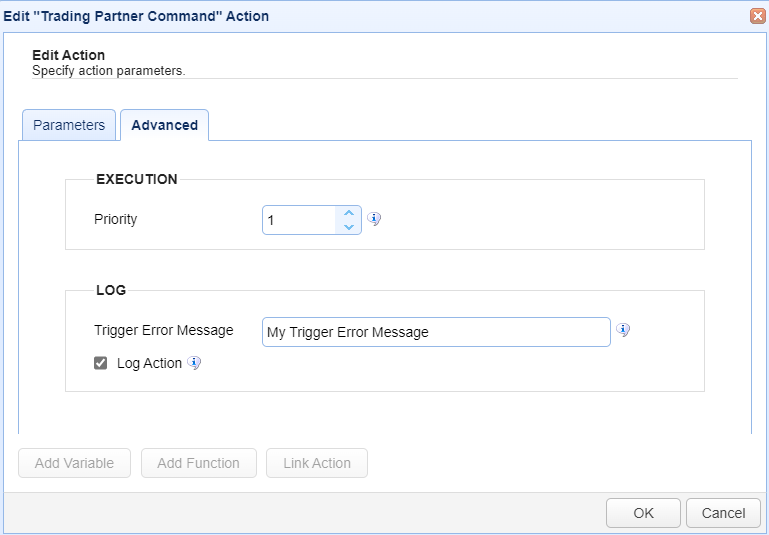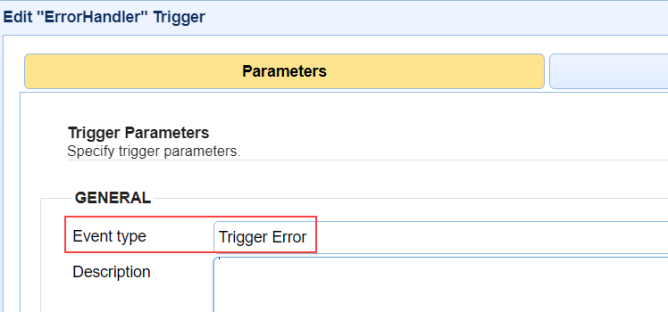Trading Partner Command
This action runs a program that you specify. The Agent and Local Directory Trading Partner types are supported in this action.

Parameters
This section describes the fields on the Parameters tab.
ACTION
Name — Identifies the name of the Action. The system-generated default name, depicted in the image above, can be changed to a different name to suit your preferences. The Name must be unique within the current Trigger workflow.
Notes — Describes the Action.
The values in the Name and Notes fields are displayed in a tooltip when you mouse over an Action node.
CONNECTION
Partner - This is the trading partner that will be used in the trigger action. The drop down list will display all the trading partners created in
AUTOMATION > Trading Partnersthat are compatible with this action. Select the desired trading partner from the list. The connection information that will be used is configured in the selected trading partner (for example, hostname, port, etc.).
TARGET
Directory - This is the working directory. A program’s working directory is the folder or directory in the file system where the program is currently running. It serves as the location for file operations, such as opening, saving, or modifying files. Note: If this field is left blank, the default working directory is the MFT Server installation directory (e.g. c:\Program Files\MFT Server).
Command - This is the fullpath of the program to execute.
Arguments - This is one or more space-separated arguments to pass to the program (if any).
Output File - This is the fullpath to a file to record the output of the program (if any output is generated). If the file does not exist, it is created. With each execution of the action, the existing file is overwritten if you specify a static file name. A dynamic file name can be configured using date/time stamp variables. For example: c:\test1\filename_%DateFormat(CurrentDate(),"MM.dd.yyyy_H.m.s")%.log.
Error File - This is the fullpath to a file to record errors during the execution of the program (if any errors are generated). If the file does not exist, it is created. With each execution of the action, the existing file is overwritten if you specify a static file name. A dynamic file name can be configured using date/time stamp variables.
Exit Code - This is the numeric return value that represents a successful execution of the program. If the runtime return value does not equal the number entered here, the command execution (not the trigger action) is considered a failure.
This trigger action is not designed to fail if the command fails (exits with a code that doesn't match the Exit Code field). It could fail for other reasons (e.g. the command is not found). If you wish to check the status of the command that is run in the Trading Partner Command action, you must create another trigger using the Trigger Event Type namedTrading Partner Command Executed. In this trigger, check on the status of the command (success or failure) using an IfBranch. The IfBranch'sParameters > Conditionfield can be set up something like this:%Success% != true(success is not true), or vice versa. From there, you can add another action that flows from the IfBranch (e.g. using the Then option), to take some kind of action due to the failure. For example, you can use a Send Email action to notify interested parties that the command exited with a code that did not match the Exit Code field value.
Advanced
This section describes the fields on the Advanced tab.

EXECUTION
Priority — Identifies the Action’s priority. An Action can be interrupted by an Action with a higher priority. The highest priority is 1. The maximum priority value is 1000. Priority comes into play when certain scenarios occur, like when Triggers or transfers are exceeded (see Settings for more information).
LOG
Trigger Error Message — Used when a Trigger Action fails. The two uses are described below.
The Trigger Error Message is displayed in the
Trigger Errorcolumn of the Action history (Triggers > History > View).
If you create an error-handling Trigger, the Trigger Error Message is passed to the error-handling Trigger.
An error-handling Trigger is a distinct Trigger that uses the
Trigger ErrorEvent type, as selected in theTrigger > Parametersdialog.If a Trigger Error event occurs, the Trigger Error Trigger runs.
The Trigger Error Message is accessible in the Trigger Error Trigger as a variable named TriggerErrorMessage.
The image below depicts the
Trigger Error Messagedisplayed in the history of a failed Trigger Action.

The image below depicts selecting the
Trigger ErrorEvent type used to handle Trigger errors.

The image below depicts a Trigger Action (part of the Trigger Error Trigger workflow) accessing a
Trigger Error Message. This is accomplished using the TriggerErrorMessage variable. To reference built-in variables, enclose the variable name in percent signs (%).

As a practical use case example, you can reference the
Trigger Error Messagein the body of an Email Action that is part of the Trigger Error workflow. The email alerts interested parties that a Trigger Action failed.Log Action — When selected, Trigger Action records are added to the
Domain > AUDIT > Loggingmodule. The state of the Action is included, such as action started, action completed, and action failed. When unselected, Action records are not added to the Logging module. However, the Trigger itself is still logged.
Buttons
Add Variable— Displays a list of built-in event variables. Each Trigger has several event variables you can use in one or more of the Trigger Action fields. When a variable is selected from the list, it is added to the Action field that is currently active. Built-in event variables are enclosed using the percent sign (e.g., %DomainName%).
In addition to using built-in variables, you can also specify a user-defined global variable, created in
AUTOMATION > Triggers > Settings. To reference a global variable ( Defining global variables), use the %GetGlobalVariable% function.
%GetGlobalVariable("DirName")% retrieves the global variable named DirName. When using global variables, specify the variable name enclosed in quotes, as depicted in this example.
Add Function— Displays a list of built-in functions. Functions are useful for formatting or parsing a Trigger event variable. When a function is selected from the list, it is added to the Action field that is currently active. For more details about functions and their usage, see Function types.
Link Action— Displays a list of Actions. When an Action is selected, the Action ID is returned.
An Action ID (a string of alphanumeric characters) is an input parameter used in the
GetActionResultfunction. This function returns the results of a previously executed Action in the current Trigger workflow. This means that Action results can be passed to a linked (following) Action.
TheGetActionResultfunction also supports using the ActionNameas an input parameter. This is an enhancement added in a more current version of MFT Server.Using Link Action
Select a field in the Trigger Action that you want to populate using the results of a previous Action.
Click Add Function. A list of functions displays.
Select GetActionResult(actionId). The field displays %GetActionResult(actionId)%.
Highlight the word
actionIdin the field.
Click Link Action. A list of Actions displays.
Select an Action. The actionId text is replaced with the Action ID.
The GetActionResult function looks similar to this: %GetActionResult("bee7cd8b-8021-4e19-8f76-1ae382e60c9d")%